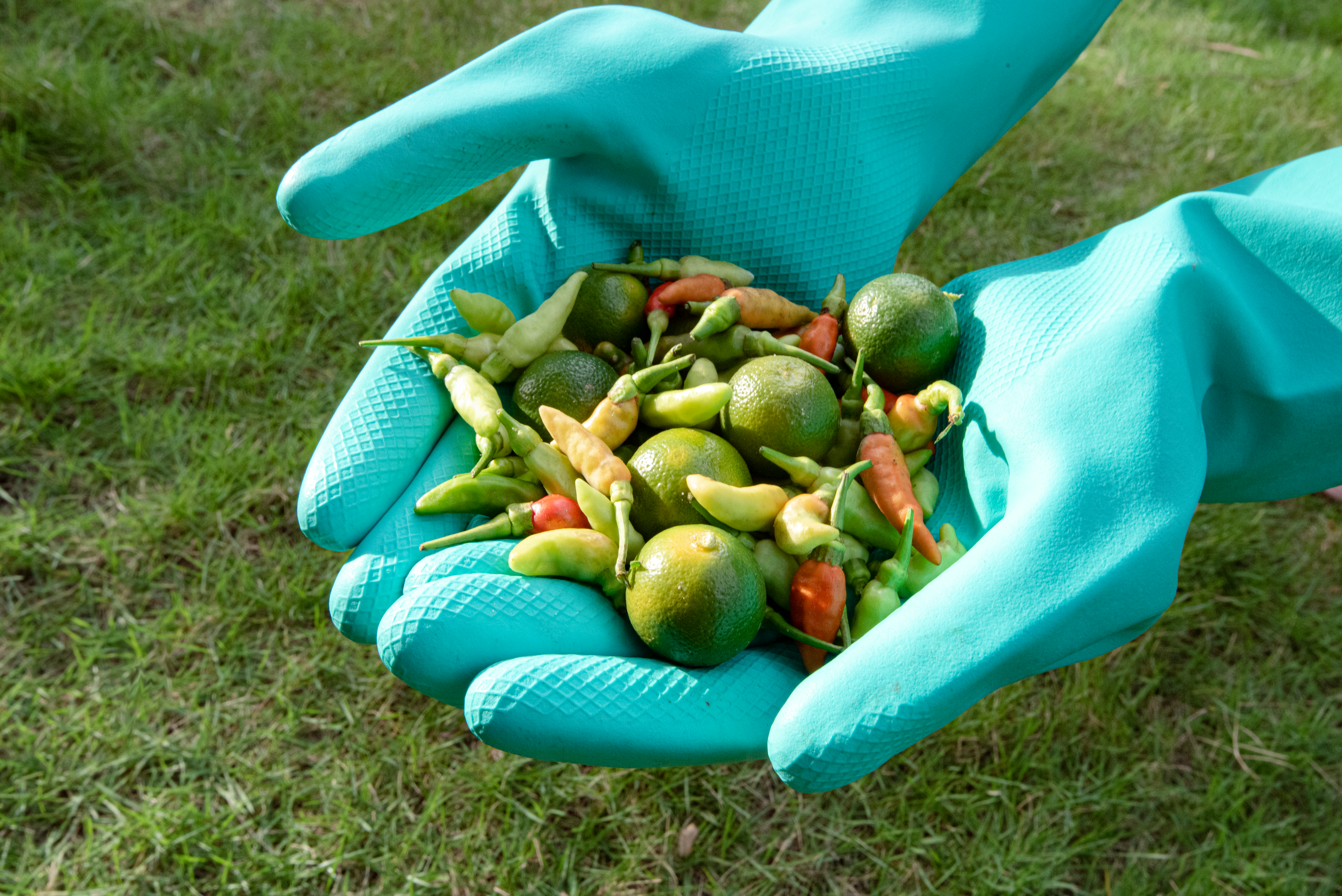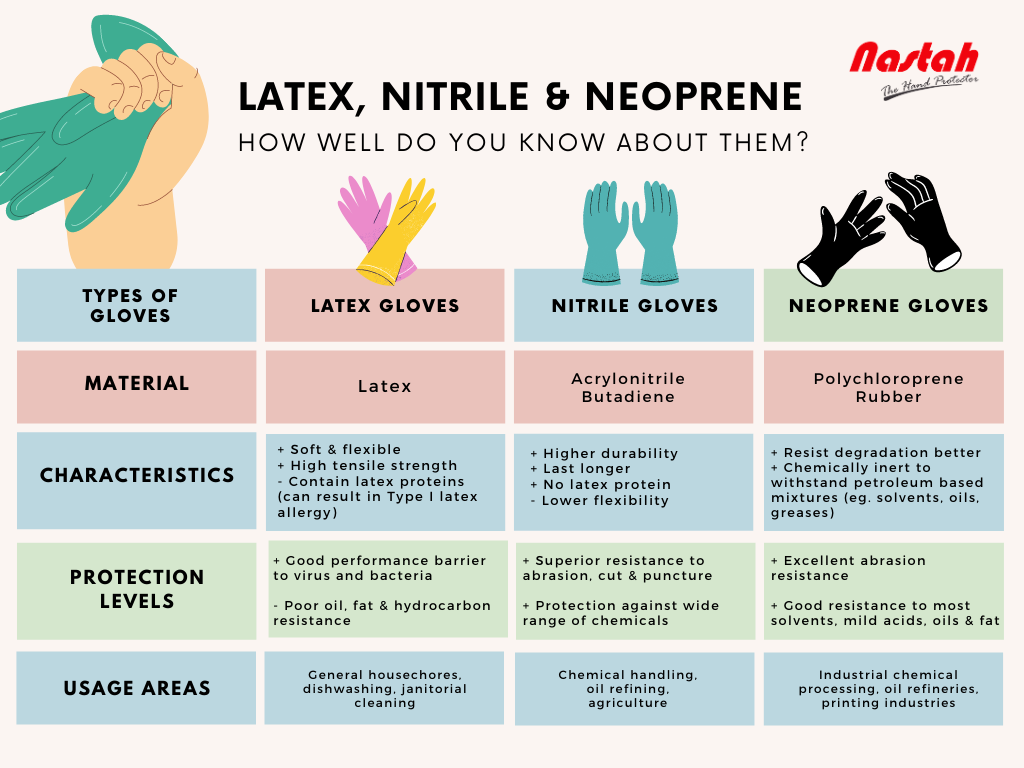Natural rubber gloves (a.k.a. latex gloves), nitrile gloves and neoprene gloves, how well do you know about them?
In our previous post, we have explained the difference between disposable gloves and reusable gloves, and we think that it is equally important for our readers to learn more about different types of gloves materials.
In this blog post we are going to cover the main difference between natural rubber, nitrile and neoprene gloves in terms of their materials, characteristics, protection level as well as usage purpose.
No time to read? Take 2 minutes to watch and understand this!
Latex gloves
Let us start with natural rubber gloves, which are made from latex. These gloves provide excellent tactile sensitivity, making them ideal for tasks that require precision and dexterity.
Before we start, we would like to share an interesting point with you regarding the terms “latex gloves” vs. “natural rubber gloves”.
Difference Between Latex and Natural Rubber
To be precise, “latex” is actually in a liquid form. And the term “natural rubber” includes all materials that are made from or contain natural latex (eg. natural rubber latex, synthetic latex, or synthetic rubber that contains natural rubber in its formulation).
So, latex and natural rubber are materials that exist in two different forms.
Latex exists in liquid form, while natural rubber exists in solid form.
And rubber gloves products are formed from natural rubber latex by dipping process.
Hence, even though the industry norm is naming natural rubber gloves as “latex gloves”, we still think that it makes more sense to name them as “natural rubber gloves”.

What Materials Are Natural Rubber Gloves Made Of?
The term “latex” refers to the milky fluid of agricultural origin obtained from the sap of the Brazilian rubber tree (Hevea brasiliensis). It is used to make natural rubber products, and it coagulates (or dries up) when expose to air.
Our natural rubber gloves are made with premium-grade natural latex compound, you might want to take a look here.
Pros and Cons of Natural Rubber Gloves:
+ Very soft and flexible resulting in a comfortable glove with good tactile sensitivity for the glove user.
+ High tensile strength (Tensile strength is the ability of a material to withstand a pulling force, gloves with higher tensile strength are more rigid and tough)
– The proteins that remain in natural latex gloves can result in Type I allergic reactions in those persons who have become sensitized to the natural latex proteins.
Protection Level of Natural Rubber Gloves:
+ Very good barrier performance to bacteria and viruses.
– Poor oil, fat, and hydrocarbon resistance compared to some synthetic alternatives.
Usage Area of Natural Rubber Gloves:
General house chores, eg. dishwashing, janitorial cleaning, gardening, etc.
Nitrile gloves

Nitrile gloves are available in disposable form as well as reusable form. For your information, some medical gloves including examination gloves and surgical gloves are also known as nitrile gloves.
We have previously written a blog post to clarify this and you might want to spend a couple of minutes to take a read.
What Materials Are Nitrile Gloves Made Of?
Nitrile is a synthetic rubber co-polymer of Acrylonitrile and Butadiene.
Our chemical-resistant nitrile gloves are made from specially formulated Acrylonitrile Butadiene compound, you might want to take a look here.
Pros and Cons of Nitrile Gloves:
+ Higher durability and last longer than natural rubber gloves.
+ Does not contain latex protein, eliminate the chance of developing Type I latex allergy.
(Take note: There are still chances that one will develop Type IV latex allergy even switching to nitrile gloves. We have written a detail article about Type I and Type IV latex allergy, you can take a look here.)
– Lower flexibility compared to natural rubber gloves.
Protection Level of Nitrile Gloves:
+ Exhibit superior resistance to abrasion, cut, and puncture compared with natural rubber gloves.
+ Provides outstanding protection against a wide range of chemicals including strong detergents, greases, oils, most solvents and acids.
Usage Area of Nitrile Gloves:
Chemical handling, oil refining, automotive industry, printing industry, agriculture etc.
Neoprene gloves

Chemical resistant neoprene gloves protect against a very broad range of oils, acids, caustics, and solvents. Neoprene offers less resistance to snags, punctures, abrasions, and cuts than nitrile or natural rubber.
Currently, we do produce neoprene gloves as well as neoprene blended with natural rubber gloves.
What Materials Are Neoprene Gloves Made Of?
Neoprene also called polychloroprene or chloroprene rubber, it is a synthetic rubber produced by the polymerization (or linking together of single molecules into giant, multiple-unit molecules) of chloroprene.
Pros and Cons of Neoprene Gloves:
+ Neoprene itself resists degradation better than natural rubber (which means these types of work gloves will last longer).
+ Neoprene glove is chemically inert and makes it ideal to withstand petroleum-based mixtures, such as solvents, oils, and greases.
– Neoprene gloves are not as resistant to petroleum products as nitrile gloves.
– Offers less resistance to snags, punctures, abrasions, and cuts than nitrile or natural rubber.
Protection Level of Neoprene Gloves:
+ Excellent abrasion resistance.
+ Good resistance to most solvents, mild acids, oil, and fat.
Usage Area of Neoprene Gloves:
Industrial chemical processing, printing industries, oil refineries, automotive paint shop, pesticides handling, agriculture, environmental waste clean up, general maintenance, etc.
Summary
Understand that some of you might prefer an infographic to have a glance at the differences, here you go:

Both nitrile gloves and neoprene gloves are good for chemical handling, but it still comes back to questions such as which kind of chemicals you are going to handle, how long you are going to expose to those chemicals, and also what kind of activities you are going to carry out.
How To Choose Gloves That Suit My Needs?
To determine if a glove is a good fit for your needs, besides considering the gloves materials, you will also need to look at the glove performance pictogram for these 4 main aspects (abrasion resistance, blade cut resistance, tearing strength, and puncture strength) to determine which aspect will be your priority during your usage.
Check out our previous post to understand more about how to determine the glove performance based on these 4 main aspects.
Generally speaking, it is hard to tell which gloves are better than the other, as different gloves manufacturers have different formulations when making the gloves, so it is not a good judgment by purely judging from the type of materials.
It is always better to ask for recommendations from gloves suppliers or sellers if you have specific chemicals to handle, or you are handling a specific situation so that the gloves can provide the best protection to your hands.
About Nastah
We hope that this article has helped to clarify the difference between latex, nitrile, and neoprene gloves.
Get in touch with us if you’re interested in learning more about what we have to offer or would like some professional advice from one of our experts.
If you’re interested in reading more articles like this, subscribe to our blog and follow our Linkedin page for the latest updates, or comment below to share your thoughts with us on this blog post.





